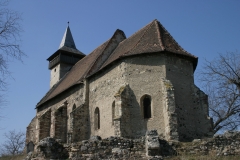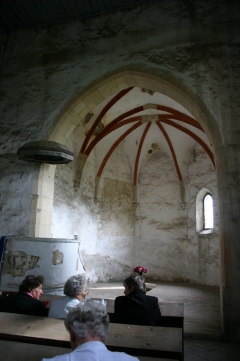

Sîntimbru (Marosszentimre) lies on the right side of Mures river, along the road that links Teius (Tövis) to Alba Iulia (Gyulafehérvár), at 8 km from the last one, on the south-eastern part of the Trascău Mountains. In 1238 and 1314 it appeared in the documents with the name of villa Sancti Emerici. The name of this settlement appears in 1326 as Sancto Emerico, in 1332 Zentemreh, in 1365 Zentemery, in 1369 Zentemerich, in 1507 Zenth Imreh, in 1648 Szent Imre. The parts of the church from the Romanian period:– the walls of the illuminator (8×6,7 m), the flat ceiling, the semi-circular stone frame of the southern gate -- they make reference to the 12th century. After 1442 János Hunyadi transformed the old church in gothic style. In the 15th century were made the polygonal shrine, the lancet windows, the vestry door-frame, the outern piers. In the same year was built the defence wall of 4-5 meters, which today lies in ruins. The next building phase period was the end of the century, the period of the Tartar invasion. It was then when the walls of the illuminator were demolished and added piers. The church preserved its gothic style up to our days. The southern wall of the illuminator is devided by four piers, and three lancet windows can be seen between the piers. The interesting part of the walled-up door are the bows made from wolf teeth, which surround three rozettes. The pulpit was built in 1742. the church vault in the shrine is in a good shape, it is complete, in the illuminator is made of wood, but earlier it could have had a gothic vault made of three parts. The flat ceiling was built in 1788, but the present wooden ceiling was built partly at the beginning of the 20th century, partly in 2008. The curiosity of the church is the original splay window, which is walled up in the south-western part of the illuminator, and the semi circular door-frame with gravations. The stone-framed door is unique in the history of the Hungarian construction style. On the walls of the church tracks of wall-paintings can be seen. The best known of these wall-paintings is the one representing Christ crying above of Jerusalem, which is situated next to the pulpit. In the northern part can be seen the memorial tablets of count Lajos Bethlen and Anna Wesselényi made of bronze in 1786. There also can be seen their tombstone decorated with their coat of arms. The tower of the church was built in the 18th centry to replace another bigger tower. The pyramidal-shaped tower’s roof is made of tin. In 2002 the village had 1223 inhabitants, of which 1180 were Romanians, 24 Hungarians and 18 gipsies; 21 inhabitants were reformed. The reformed church, of which in 1937 the Hungarian poet Zoltán Jékely wrote the famous poem In the church of Marosszentimre, was restaurated with the help of the Ágoston Sándor Foundation and the Bod Péter Foundation and its volunteers between 2006-2007.
Reverends: Ambrus catholic priest (1529), András Feltóty (1589)



